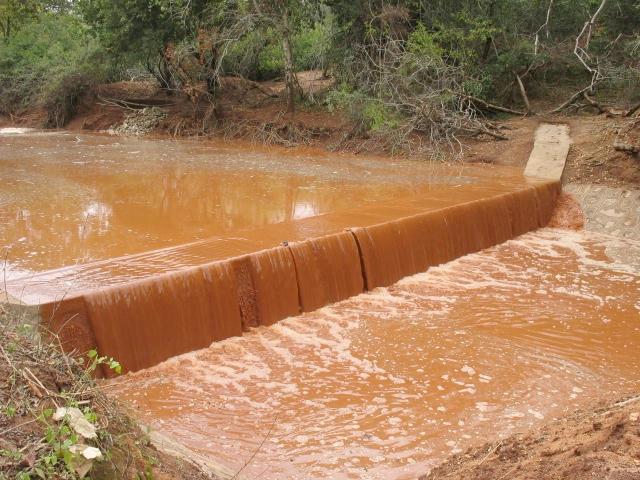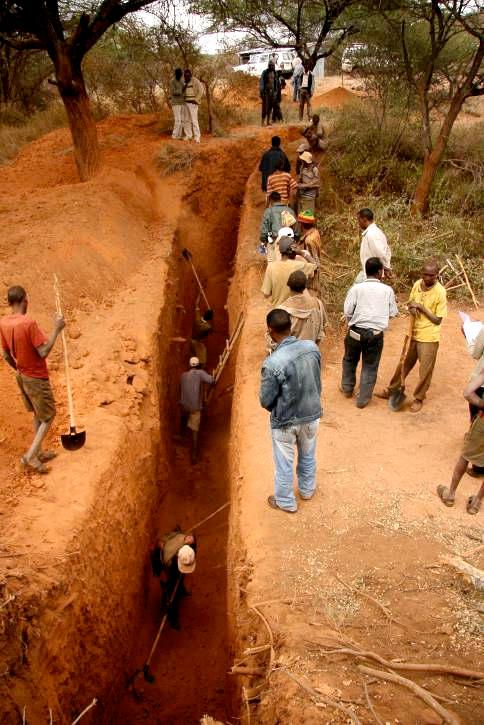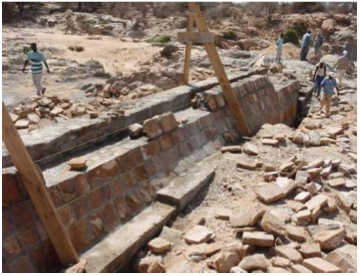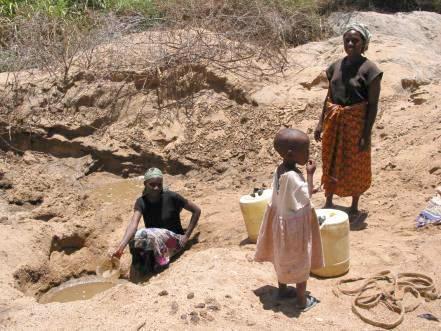Difference between revisions of "Water Portal / Rainwater Harvesting / Groundwater recharge / Sand dam"
(→Construction, operations and maintenance) |
(→Building the sand dam (and wing wall)) |
||
| Line 64: | Line 64: | ||
[[Image:SandDamConstruction.JPG|thumb|right|200px|Sand dam under construction. Somaliland. Eric Fewster, BushProof / Caritas]] | [[Image:SandDamConstruction.JPG|thumb|right|200px|Sand dam under construction. Somaliland. Eric Fewster, BushProof / Caritas]] | ||
* The method depends on the type of dam and the type of ground. The construction of sand dams in cascades improves total storage and efficiency and minimizes seepage losses. Dams made of concrete, stone-masonry (cheapest and easiest) and brickwork require skilled labour for construction, but are stronger and have a longer lifespan. | * The method depends on the type of dam and the type of ground. The construction of sand dams in cascades improves total storage and efficiency and minimizes seepage losses. Dams made of concrete, stone-masonry (cheapest and easiest) and brickwork require skilled labour for construction, but are stronger and have a longer lifespan. | ||
| − | * Key into banks | + | * Key into banks or construct wing walls to avoid erosion around edges of the sand dam. Where wing walls are built, a good technique is to start with the wing walls and work inwards to the centre, since community enthusiasm lags by the time wing walls are constructed (if not built first), yet they are essential to proper functioning. Length of the wing wall varies according to bank characteristic: loose riverbanks, 7 metres; hard soils, 5 metres; hard & impermeable soils or rocks, wing wall is not needed. Planting napier grass along upstream riverbanks controls erosion and fixes the course of the river in a flood. |
* The height of wall built before each flood event should not exceed accumulation rate of coarse to medium sand during that flood event, otherwise ponding & silt deposition will occur, which can lower specific yield and higher capillarity, then lead to limited extraction rates in wells upstream and more water lost to evaporation. Dams at 1.3m depth showed that where finer material content (0.063 mm or less) is increased, specific yield is known to decrease remarkably. Accumulation rate and therefore height varies according to location and should be adjusted at each site after the first flood event demonstrates the rate of accumulation. Height per stage will probably be between 0.3 metre and 1 metre per stage according to experience from past projects. Some silt deposition will always occur as velocities decrease toward the end of the flood event; the idea is to limit its quantity in final sand volume. | * The height of wall built before each flood event should not exceed accumulation rate of coarse to medium sand during that flood event, otherwise ponding & silt deposition will occur, which can lower specific yield and higher capillarity, then lead to limited extraction rates in wells upstream and more water lost to evaporation. Dams at 1.3m depth showed that where finer material content (0.063 mm or less) is increased, specific yield is known to decrease remarkably. Accumulation rate and therefore height varies according to location and should be adjusted at each site after the first flood event demonstrates the rate of accumulation. Height per stage will probably be between 0.3 metre and 1 metre per stage according to experience from past projects. Some silt deposition will always occur as velocities decrease toward the end of the flood event; the idea is to limit its quantity in final sand volume. | ||
* Avoid downstream erosion problems by making a protective slab (stilling basin) at the base of large stones set in concrete. Dimensions to be designed, but is not necessary where there is exposed rock bar downstream. | * Avoid downstream erosion problems by making a protective slab (stilling basin) at the base of large stones set in concrete. Dimensions to be designed, but is not necessary where there is exposed rock bar downstream. | ||
| Line 71: | Line 71: | ||
After the dam is built, an outlet for water extraction must be constructed for drinking, agriculture, etc.. Hand dug scoop holes are the simplest possibility, however the water can easily be contaminated. Covered wells, with hand or rope pumps protect the water much better. It is also possible to construct an outlet pipe with a tap. This however is difficult to maintain, and can weaken the dam. Meanwhile the local community needs to be trained to manage and maintain the dam. | After the dam is built, an outlet for water extraction must be constructed for drinking, agriculture, etc.. Hand dug scoop holes are the simplest possibility, however the water can easily be contaminated. Covered wells, with hand or rope pumps protect the water much better. It is also possible to construct an outlet pipe with a tap. This however is difficult to maintain, and can weaken the dam. Meanwhile the local community needs to be trained to manage and maintain the dam. | ||
[[Image:Sand dam scoop hole.JPG|thumb|right|200px|Women fetching water from a local aquifer through scoop hole]] | [[Image:Sand dam scoop hole.JPG|thumb|right|200px|Women fetching water from a local aquifer through scoop hole]] | ||
| − | [[Image:Sand dam well.JPG|thumb|right|200px|Closed well near a sand dam]] | + | [[Image:Sand dam well.JPG|thumb|right|200px|Closed well near a sand dam]] |
| − | + | ||
====Maintenance==== | ====Maintenance==== | ||
If done timely, the maintenance required is not costly. Small malfunctions in the dam however can lead to destruction of the entire dam. Therefore, the dam should be regularly checked for cracks and damage. Particularly after floods, and extreme temperature changes cracks are likely. These need to be repaired as soon as possible by a trained mason. | If done timely, the maintenance required is not costly. Small malfunctions in the dam however can lead to destruction of the entire dam. Therefore, the dam should be regularly checked for cracks and damage. Particularly after floods, and extreme temperature changes cracks are likely. These need to be repaired as soon as possible by a trained mason. | ||
Revision as of 22:47, 30 March 2012
Regions with highly erratic rainfall often have rivers with temporary seasonal sandy bed streams. They only experience heavy water run-off for short periods of time after rain. During such periods of high flows, large quantities of sand are transported downstream. Some sand can get trapped on the upstream sides of rock outcroppings along the stream. The sand traps form natural water storing aquifers. Sand dam technology provides a means to reproduce this water collecting mechanism and to increase the size of existing aquifers.
Water in natural collection sites is usually clean for drinking but limited and quickly gets depleted. Sand dams are an artificial improvement of sand beds where more water can be recharged and stored for water use. A dam of concrete, clay soil or stone masonry is constructed across the channel at specific sites to trap and hold back the sand during flooding; this creates an additional sub surface water bank to be harvested during the dry season.
With an accurate and appropriate location choice the total amount of water available in the sand dams can be over 6000m³.
Sand dam projects here have not only improved water availability, but benefited the community socially and economically. Locals are trained to participate in construction of the dam, maintenance, financial management, and also in natural resource management.
Suitable conditions
Expert input is required to determine the best site for the dam and to make sure the project is adapted to the physical conditions as well as social circumstances of the local community. Having a lead artisan per catchment area to decide on siting seems to help success rates. Physically, the site must be suitable for construction of a dam, provide safe drinking water, and be able to use sand sedimentation to increase water availability. Firstly it must be decided if the river is appropriate, secondly the best section of riverbed must be chosen, and then the optimum location for extraction.
Generally, the dam requires a sandy riverbed in a hilly area. Preferably the riverbed consists of coarse sands laid on impermeable bedrock. The river should be seasonal but must have a base flow. Whether this is the case can be determined by the type of vegetation growing around the river. The river shouldn’t be too wide (max. 25m) and should have two high riverbanks.
Ensure the sand dam is not built in an area where water will bypass the structure. Riverbanks should be equal in height and tall enough (height of dam + height of flood +10%), and the dam should not be constructed near the bend in a river.
Site where there are no possibilities for the water to leak away:
- On impervious bedrock or clay rather than rock with fractures. A good indicator is whether there is some preexisting subsurface flow in the dry season or not and if there are large stones & boulders seen in the riverbed. Extra care should be taken when siting as seepage can occur under the dam in such cases.
- On the base layer rather than on the intermediate clay lens within sand.
- Between defined banks with no old riverbeds on either side which could allow sub-surface water around dam edge.
Site in areas where gradient is suitable to get sand rather than silt. A flow of at least 0.45 m/s river flow means less silt deposition, and such areas will be where there is a suitable gradient – too flat and there will be too many small particles and silt. Flatter gradients also mean wider riverbeds, and for sand dams it should really be limited to 25 metres width. An optimum gradient is said to occur between 0.125% and 4% but can be higher than this but then the sand volume stored is less. An easier field test might be to do a sand analysis to find size distribution, or a porosity & specific yield test from which one can extrapolate the likely sand type. Medium sand will have the best balance between porosity and specific yield, and is therefore the type that is needed.
Site where river is narrower and where there is a natural barrier to groundwater flow. This results in cheaper construction while maximizing sand already present. Such barriers can be found by seeing where water will remain in scoop holes after rains, or through probing, augering & trial pits, or other techniques such as drilling with air compressor.
Avoid siting where halite (white & pink rocks) is present in riverbanks upstream. These may make the water saline.
Have a sequence of dams in the same river to avoid everyone using a single source with possible ecological damage as a result. However, having dams too close together means their areas of influence overlap. This enables water levels to rise in general, but the total quantity of water available decreases. Quantity is more important regionally, therefore minimum distances might be employed between dams (350m either side of dam was zone of influence in Kenya with a 700m minimum, but this might vary according to site).
These conditions and also others related to, for example; climate, presence of boulders, or gradient of the riverbed must be analyzed in detail to determine suitability of the site. Also, though it can be artificially improved, the water quality must be good enough for drinking (not too saline, contaminated, etc.)
| Advantages | Disadvantages |
|---|---|
|
- Year-round source of good quality water |
- External expert knowledge needed |
Construction, operations and maintenance
First a trench needs to be dug. Its position is marked out using pegs. Then it is excavated and the soil placed downstream. It can also be dug out into bedrock. It should then be checked for weathering zones and cracks. Round bars are placed vertically along the trench to reinforce it. Then a foundation is laid consisting of 2 layers of cement with barbed wire in between. Once this has set, the trench is filled with masonry of mortar and hardcore. The wing walls and final dam wall can then be constructed. Finally any exposed parts of the construction are plastered.
Building the sand dam (and wing wall)
- The method depends on the type of dam and the type of ground. The construction of sand dams in cascades improves total storage and efficiency and minimizes seepage losses. Dams made of concrete, stone-masonry (cheapest and easiest) and brickwork require skilled labour for construction, but are stronger and have a longer lifespan.
- Key into banks or construct wing walls to avoid erosion around edges of the sand dam. Where wing walls are built, a good technique is to start with the wing walls and work inwards to the centre, since community enthusiasm lags by the time wing walls are constructed (if not built first), yet they are essential to proper functioning. Length of the wing wall varies according to bank characteristic: loose riverbanks, 7 metres; hard soils, 5 metres; hard & impermeable soils or rocks, wing wall is not needed. Planting napier grass along upstream riverbanks controls erosion and fixes the course of the river in a flood.
- The height of wall built before each flood event should not exceed accumulation rate of coarse to medium sand during that flood event, otherwise ponding & silt deposition will occur, which can lower specific yield and higher capillarity, then lead to limited extraction rates in wells upstream and more water lost to evaporation. Dams at 1.3m depth showed that where finer material content (0.063 mm or less) is increased, specific yield is known to decrease remarkably. Accumulation rate and therefore height varies according to location and should be adjusted at each site after the first flood event demonstrates the rate of accumulation. Height per stage will probably be between 0.3 metre and 1 metre per stage according to experience from past projects. Some silt deposition will always occur as velocities decrease toward the end of the flood event; the idea is to limit its quantity in final sand volume.
- Avoid downstream erosion problems by making a protective slab (stilling basin) at the base of large stones set in concrete. Dimensions to be designed, but is not necessary where there is exposed rock bar downstream.
- In upstream parts of a catchment it is recommended that sand dams are always built in stages, since the availability of coarse material is generally limited and base flow is small or absent (base flow = sub-surface flow which aids surface flow so that silt/clay can still be flushed away once rainfall stops, rather than sinking directly into the sand bed). It has also been suggested that to build in stages over several years is also more beneficial for functioning of dam committees. Build them within a spillway, which was part of the first stage & wing wall construction.
After the dam is built, an outlet for water extraction must be constructed for drinking, agriculture, etc.. Hand dug scoop holes are the simplest possibility, however the water can easily be contaminated. Covered wells, with hand or rope pumps protect the water much better. It is also possible to construct an outlet pipe with a tap. This however is difficult to maintain, and can weaken the dam. Meanwhile the local community needs to be trained to manage and maintain the dam.
Maintenance
If done timely, the maintenance required is not costly. Small malfunctions in the dam however can lead to destruction of the entire dam. Therefore, the dam should be regularly checked for cracks and damage. Particularly after floods, and extreme temperature changes cracks are likely. These need to be repaired as soon as possible by a trained mason.
Further, the outlet and upstream riverbed should be cleaned regularly to make sure the dam does not get blocked. Silt, rocks, dead animals, etc. should be removed regularly. This can also help prevent contamination of the water. The quality of the water in the well should be checked, once in a while, by an expert.
Estimated Lifespan
The lifespan depends on the materials used and expertise with which it is constructed and maintained. The dams in Kitui Kenya were built at a cost of 7500 USD and have a minimum lifespan of 50 years.
Costs
The construction of dams is largely carried out by the local community. Costs mainly relate to local availability of cement, masonry and professional supervision.
Cost of introduction:
- Material: US$ 5,500
- Other costs: US$ 500
- Labour: - skilled: US$ 2,500 - unskilled: 900 man days -
Cost of maintainance:
- Operation and maintenance: 5 days per year
Case studies
In Kenya, it has been used with good outcome in the Kitui, Machakos and Samburu districts. Other countries with similar dry environments such as the U.S.A, Thailand, Ethiopia and Namibia also have used it in numerous and diverse forms.
Kitui district, Kenya: SASOL Foundation has since 1995 built over 500 dams. They are built using locally available materials and are partially (40%) financed by the local community. The community is also involved in the construction and maintenance. Sand management groups were formed to aid in the construction of dams and to maintain them after.
The dams not only provide a steady source of drinking water, but also have further social and economic benefits. They provide irrigation for cash crops and other commercial rural activities, piped water for industrial activities in nearby villages. Further due to the large number of dams, the water table rises over a large area and therefore stimulates ecological regeneration.
Borana Zone, Ethiopia: Communities in this area depend on agriculture and livestock farming, which is very limited due to the unstable water supply. In 2007 several NGOs implemented 7 sand dams and 10 surface runoff tanks. This combination should provide a reliable source of water for 10 communities in the area. The project will in the future expand to other parts of the country also.
Reference manuals, videos, and links
- Manual: A practical guide to sand dam implementation. Rainwater Harvesting Implementation Network (RAIN).
- Video: Kitui Sand Dams - CPWC
- Video: RAIN sand dam workshop & field visit in Ethiopia, 2009, by RAIN foundation and EHRA.
- Video: Sand dam movie - Excellent Development.com
- www.sanddam.org - All information on sand dams
- Sasol Project Kenya
- ACACIA Water
- UNEP
- IAH
- Water for Arid Land
- Practical action
- Excellent Development
Acknowledgements
- CARE Nederland, Desk Study Resilient WASH systems in drought prone areas. October 2010.







